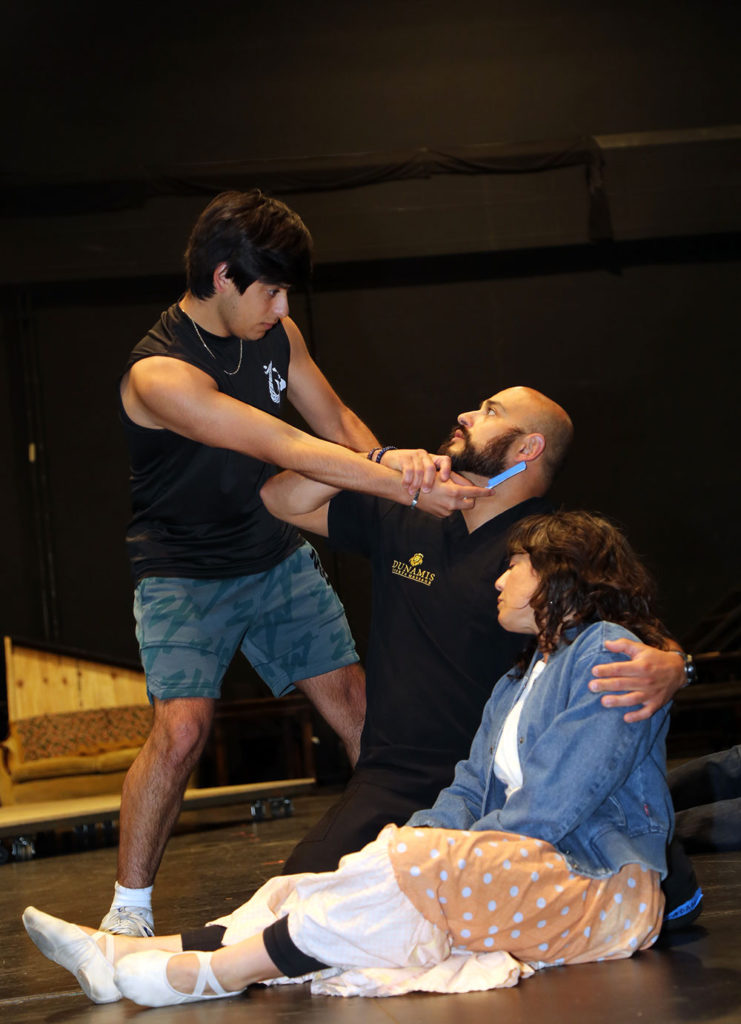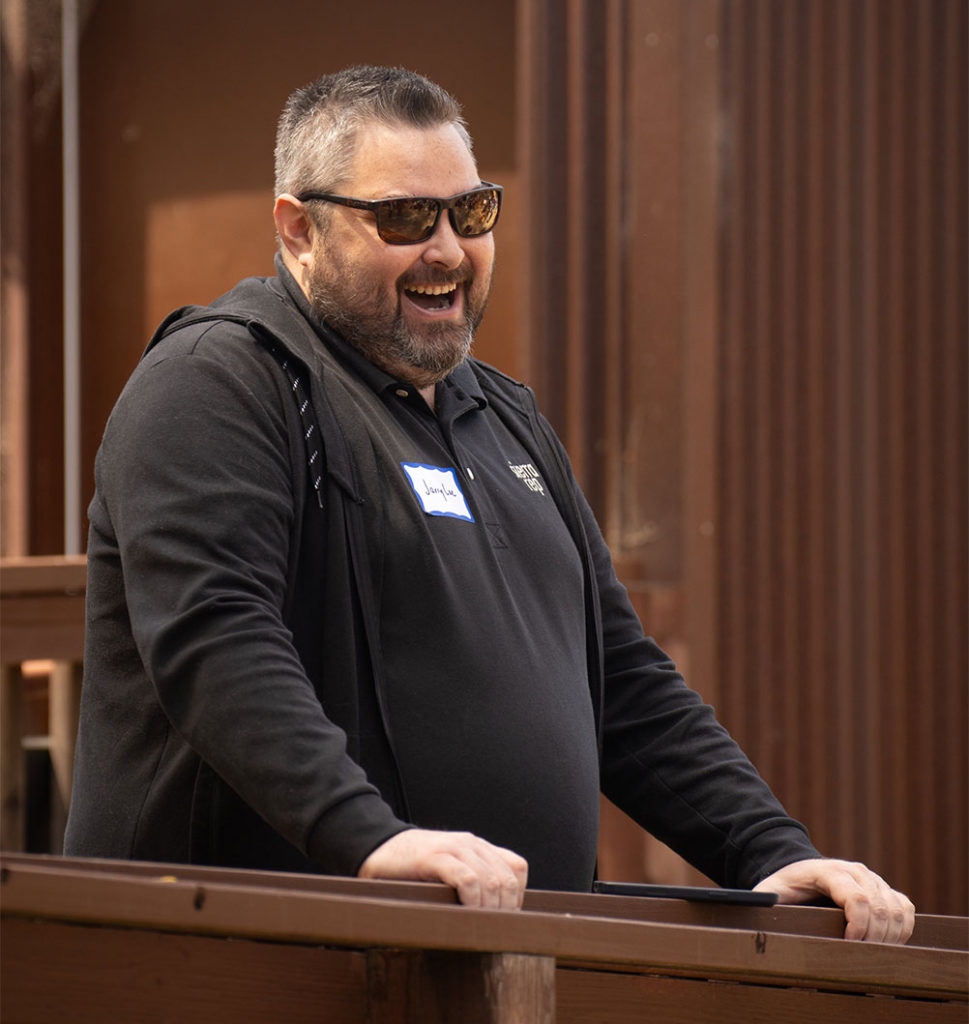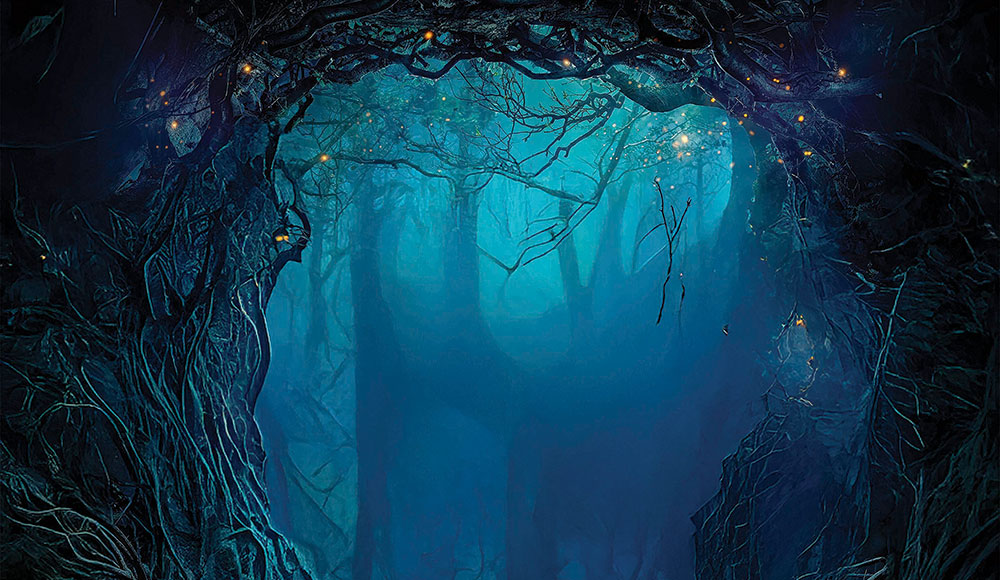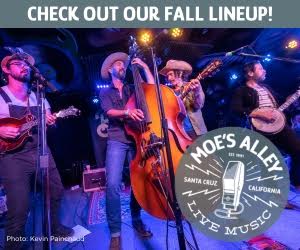Two of the biggest Broadway hits of all time are playing right here in Santa Cruz this summer. And they’ve got something in common: both were penned by Stephen Sondheim, the American composer and lyricist who changed the way Broadway musicals were done, before he exited the stage four years ago.
A giant among giants, Sondheim rewrote the way song and story were presented on stage. He won a Pulitzer Prize, eight Tony Awards, an Oscar, eight Grammys, the Presidential Medal of Freedom, and had two theaters named for him. One in London, the other on Broadway.
But don’t take the critics’ word for it. Starting next week, go see Cabrillo Stage’s production of Sweeney Todd (Cabrillo Stage) and Santa Cruz Shakespeare’s Into the Woods. And fasten your seat belts.
Neither of these provocative works are musicals in the My Fair Lady mold. They are not sugar-coated pieces of entertainment. They ask disturbing questions, and offer disturbing answers plucked from the depths of the unconscious. They are more than a little dark, and very funny.

Once Upon a Time
“And ah, the woods,” Sondheim wrote. “The all-purpose symbol of the unconscious, the womb, the past, the dark place where we face our trials and emerge wiser or destroyed.”
Sondheim and Into the Woods (1987) collaborator James Lapine took familiar fairytales, found in almost every culture on the planet, and brought them together in one theatrical space. Along with a modern-day baker and his wife desperate to have a child, we will meet Cinderella, Little Red Riding Hood, Jack and the Bean Stalk and Rapunzel.
These familiar Grimm Brothers characters will literally bump into the baker and his wife, who have been warned by a witch that they have only three nights to find a cow as white as milk, a cape as red as blood, hair as yellow as corn, and a slipper as pure as gold. And only then will they be able to have a child. In the first act, their dreams come true. In the second act, they pay the consequences.
Barber Chops
Ten years earlier, in 1979, Sondheim created Sweeney Todd, The Demon Barber of Fleet Street, a macabre masterpiece set in Victorian London. From Christopher Bond’s play about a murderous barber, Sondheim crafted the melodrama with writer Hugh Wheeler.
Upon his return from unjust exile in Australia, Sweeney seeks violent vengeance on the corrupt judge who convicted him. Just how Sweeney gets his revenge involves some gruesome barbershop escapades, and the help of his equally wicked neighbor Mrs. Lovett. Mrs. Lovett bakes pies filled with, well, you really don’t want to think about it.
On stage the deliciously gruesome tale is transformed into theatrical magic by the genius of Sondheim’s music, plotting, and irresistible rhyming and wordplay.
Jerry Lee comes from Sierra Repertory Theatre to direct Santa Cruz Shakespeare’s first musical offering. And Andrea L. Hart enters her third season as the artistic director of Cabrillo Stage. I asked the two directors about their concept and preparation.

Jerry Lee on ‘Woods’
Good Times: Quite an assignment. This is the first musical for Santa Cruz Shakespeare, and you’re at the helm. How did Charles Pasternak find you?
Jerry Lee: I’m the artistic director at Sierra Repertory Theatre in Sonora, and right after the pandemic Charlie joined us for Murder on the Orient Express, which I directed, and we stayed in contact all this time. I was trained as an actor, but directing is where I’m finding myself more comfortable. I love creating the worlds of these plays and musicals. Instead of calling myself either an actor or a director, I prefer to think of myself as a storyteller.
You’ve directed this show before and acted in it as well. Talk about its challenges.
JL: Into the Woods is emotionally and technically huge. And it’s kind of a giant, just so full of everything, comedy and drama. I think that’s what will surprise people. It’s very much like Shakespeare. It’s funny until it isn’t, and then it’s devastating. Woods and Midsummer Night’s Dream complement each other very well. Every time the characters journey into the woods, it’s about transformation.

Yes, it’s very much about how we really don’t know who we are.
JL: Absolutely—that’s really the whole point. I’ve been thinking about this idea, about finality, our preoccupation with it. We imagine that if I do this, and if I do that, I’ll get what I want and then I’ll live happily ever after. It’s just so arrogant and so human. This musical explores the whole concept of happily ever after. Act One is about getting your wish. And Act Two is where you realize that happily ever after does not truly exist. There’s always going to be something unknown.
What are the unique pleasures? What is it that you always take away from Into the Woods?
JL: Well, the music is so beautiful! I make a joke that people don’t necessarily understand. I always say if I could rent an apartment just in the string section of this orchestration, I’d be happy. I just love living in this music.
But what about the complex wordplay?
JL: Sondheim was very open about how he loved puzzles. He would create puzzles in his work, and use wordplay, and there are hidden jokes and hidden meanings in there for actors and the creative teams to work on. They’re fun clues for us, and they speak to our storytelling and our connection between the material and the writer as well.
What’s been most difficult about directing a play like this, about mounting it successfully? Where are the big challenges?
JL: Working inside of the parameters that are set by a repertory season. They’re exciting parameters to have in place, because you’re forced to be creative. This is a show that’s built for about 17 actors, and we have 11 actors, so we had to figure out some creative doubling, which we’ve done. Our production is literally about transformation.
Give us an example.
JL: For instance, our two actors who are playing the princes, Rapunzel’s prince and Cinderella’s prince, play the two step-sisters—and also play two other characters. It was a fun exercise in finding parallels inside of stories, and so these two actors are tracked through the play as siblings, just as we’re looking at all different kinds of relationships, parents, grandparents. Yeah, it’s very exciting.
What do you think about the fit of these three shows—Into the Woods, A Midsummer Night’s Dream and Pericles—in this SCS season?
JL: We really did take the time to find the right ensemble to make this kind of alchemy work with a reduced cast and all the doubles and the necessity of finding people who really understand musical theater and acting. It certainly seems like the three stories are adventure stories or journey stories. They complement each other very, very nicely. My very first primary focus was getting in there and seeing what these woods are like. It was so beautiful and welcoming and just the sheer beauty of that space. The fabulous design of this production, especially these amazing costumes by Austin Blake Conlee. It’s going to feel sumptuous and dramatic and very, very funny.

Andrea Hart on Sweeney Todd
Give us an idea of how you came to work with Cabrillo Stage.
Andrea Hart: I came from Kansas and worked in theater in the Bay Area for 18 years. Started a couple of theater companies, writing plays, and self producing. I worked in a ton of schools and then I met my partner. We moved to San Diego for a year for his job, then I got a masters at UT, Austin, and he got a job at Elkhorn Slough Foundation. And then the job opened up at Cabrillo Stage. That master degree came in handy when I applied for the job!
Have you found ways to make this program your own?
AH: It’s year three for me and it’s been gradual. I’ve done a ton of musical theater because I was an educator and that’s what schools do. But my heart is in new theater and plays so I approach musicals in that way. What is the core of it? What is the deep story here? I analyze the lyrics like I would Chekhov. I question every line of a song—what are you saying there? Who are you saying it to? Why are you saying it?
Why did you choose Sweeney Todd?
AH: Now that I’ve gotten to know the community better, I’ve been exploring more ideas, such as expanding into a two-show season. But I wanted it to be sustainable, and given Cabrillo»s schedule two shows was going to be a tight turnaround. So I began to rethink, and thought OK, let’s do one big show. And Sweeney, to me, is perfect for a one-show season, because it’s so huge. It can hold the season all by itself.
Sweeney Todd was a courageous choice.
AH: I worried that it’s not right for very young kids, and it might be too dark. People might not want to see a dark show during the summer. But Cabrillo Stage doesn’t have to be everything for everyone. On the other hand we can do things with Cabrillo Stage that we can’t do in other places, which is, have a 21-person orchestra, which this show requires, and we can do it in a really big, fully fleshed-out way scenically and cast-wise.
I just started getting into the female characters—they are amazing. Mrs. Lovett. Sondheim has called her the true villain of the show. She makes everything happen. And even Joanna. What a beautiful representation of someone in dire straits who does not give up looking for the way out. And the hope and the optimism. She says, teach me how to sing. Even if I can’t fly, how can I sing? So I found these exceptional characters, even the beggar woman who sees everything that’s going on but people assume is crazy. Once I was hooked, I really wanted to do this show. We chose it last October, and since then I’ve seen how this show is so appropriate for this moment in time.
How does Cabrillo Stage’s funding and casting work? Do you have a core you must work with? Do you have enough budget to hire equity actors?
AH: That’s funny because it’s not well understood. So Cabrillo Stage is a part of Cabrillo College only in certain ways. We don’t pay for facilities, so we have rent-free rehearsal space and performances. My artistic director salary is paid. Certain things like that that are funded. Everything else we fundraise for. Cabrillo Stage is not part of the college’s curriculum. I work with the foundation. We’re constantly trying to build our core of donors back up. We’ve gotten an Arts Council Santa Cruz grant the last two years and we’ll get it next year too, which is great, and we have a new person helping me with grants. When I looked at our budget I knew we needed to diversify this funding. We cannot keep relying on ticket sales being the only way that we fund what we’re trying to do.
Our audition are broadly advertised. We had over 150 people audition for this show. We have different tiers. Hourly people who work in the shop and build sets. Then we have designers on a stipend. And students on scholarships. To me the ideal is an apprenticeship arrangement where people begin with minimal responsibilities and then move up. Like our stage manager this year, who went from Cabrillo to UCSC to New York, and now she’s back stage managing for us and training two assistant stage managers, while working on a show back east.
Any equity actors?
AH: This year, we were able to hire an equity actor, Adam Saucedo, to play Sweeney. He’s also a great story, because he has acted for Cabrillo Stage two or three times in the past. He was Gomez in the Addams Family before he was equity, and now he plays Sweeney. There are people who repeat, who have been in shows past, and then there are brand-new people. And it’s like an educational program, you know. When it’s working well there are students working alongside professionals at every phase or in every part of the production. And that is the true apprenticeship.

What’s special about this Sondheim play, and about the character of Sweeney Todd?
AH: It’s such a social commentary, you could paste it onto our current time period. The show is set during the Industrial Revolution. People are afraid. Machines are replacing them. And here we have our own revolution, AI replacing humans. So in Sweeney people have to scramble to hang on to what they have. People against each other. Sweeney sings, “there’s two types of men in the world, the one staying put in his proper place, and the other one with his foot on the other man’s face.” It’s all about class warfare, and it’s about a society where people feel like they have so few choices that violence becomes inevitable. And it becomes almost celebrated, like the United Healthcare CEO who was shot, and his killer becomes almost a full hero. It’s not like sadness over the shooting. It’s like celebration, because people felt like they didn’t have any other voice. Theater should be asking these types of questions; what happens to a society when they’re at that point?
Is live theater important in an iPhone era?
AH: Stepping into a theater is like you’re making a choice. You are throwing your hat in the ring of interpersonal connection, and breathing the same air as somebody else looking at a live creation. Theater is so powerful and so necessary for that reason. You’re sitting next to people you don’t know, and you maybe have completely differing views from, and yet you’re laughing and sighing and crying at the same things.
Two Sondheims in one summer. Is this workable scheduling?
AH: Charles and I meet once a year and chat, and at one breakfast he told me they wanted to do Into the Woods. I had already picked Sweeney because it was right for us. This community is going to get two of Sondheim’s masterpieces but done in two completely different ways, in two completely different settings. What you will see and experience at the Grove is going to be so different from what we have in mind at Cabrillo Stage.
NEXT: Read Christina Waters’ interview with Charles Pasternak
Santa Cruz Shakespeare’s production of Into the Woods runs July 15–Sept. 20. Tickets: santacruzshakespeare.org.
Cabrillo Stage’s production of Sweeney Todd runs July 17–Aug. 10. Tickets: cabrillostage.com.














nice